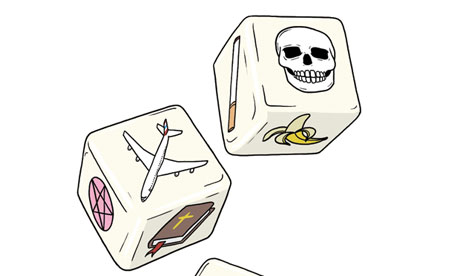
Norm, Prudence and Kelvin each see an unattended bag in a station. Norm worries it might be a bomb but weighs up the risk and decides it's most likely to have been left behind by accident. Prudence has a panic attack and insists the station is put on alert. Kelvin helps himself to the laptop inside. BOOM! Sadly, in the case of Norm, the bag was a bomb and he has been scattered all over Waterloo station.
We all have a different attitude to risk. Most of us are happy to leave the house and take the million-to-one chance that Nick Clegg might fall out of a window and land on our head, killing both of us. Some might even call it a public service: taking one for the team. The thing about million-to-one chances is that they do happen to one person. Or in our case two. We thought there was next to no chance of our book being chosen for Digested Read. But there you go.
So what are the real dangers and risks involved in everyday activities? It helps to divide probability into MicroMorts (MMs) whereby a 100,000-to-1 chance of death = 1MM. The information that most parents want is how to reduce the MM level for their own children: as most accidental infant deaths occur within the parental home, it clearly makes most sense for children to be left outdoors at all times. Not feeding them also substantially reduces the possibility of them getting a fatal dose of salmonella.
Norm has played the odds and survived his childhood but, being a curiously average man, wants to know his chances of meeting an avoidable accidental death as an adult. He is distressed to find the average MM runs into several hundreds for this, until he discovers that over-80s skew the figures upwards, since their rate for accidental death exceeds 1,200MMs. So Norm resolves to kill himself when he is 79 and then settles down to enjoy a much safer life. He also endeavours to remain completely friendless – something his obsession with statistics makes surprisingly easy – as he has read that most murders are committed by people known to the victim.
Yet Norm is a worrier and he has also read that eating a fry-up every morning increases the likelihood of him getting pancreatic cancer by 20%. What he doesn't understand is that he still has sod-all increased risk of getting pancreatic cancer. When this is explained to Norm, he decides to tuck in. He is now obese and has heart disease.
Kelvin has a very feckless friend called Boris. Boris hasn't yet grasped that having unprotected sex with women is likely to result in unwanted pregnancies. Were Boris to understand the fecundability estimate, he'd know the following: although a couple having unprotected sex have an 85% chance of not conceiving in any given month, this equates to an 86% chance of getting pregnant within a year. And the number of illegitimate children born in London might decrease significantly. Only saying.
Lifestyle is another worry for Norm. Were he live to an average age, he now has 500,000 hours left to live. Which, for our purposes, equates to one million Micro Lives of 30 minutes. Norm is very conscious of wasting a lot of his life, not least the past five hours reading a book he isn't sure he has entirely understood, so he wants to use up the rest of his Micro Lives sensibly. He discovers that smoking one cigarette uses up two Micro Lives and ages him by an hour per day. This fact provides him with the answer: by smoking just one cigarette per day, he can effectively turn a 24-hour day into a 25-hour day and use the extra hour he has gained to smoke more cigarettes. This way he can theoretically live for ever. He then remembers he has already smoked 250,000 fags, so he is technically already dead.
Digested read, digested: Numb and number

